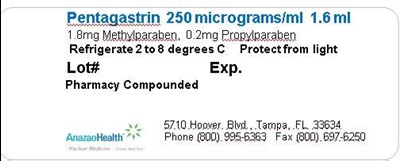FDA Label for Pentagastrin
View Indications, Usage & Precautions
Pentagastrin Product Label
The following document was submitted to the FDA by the labeler of this product Anazaohealth Corporation. The document includes published materials associated whith this product with the essential scientific information about this product as well as other prescribing information. Product labels may durg indications and usage, generic names, contraindications, active ingredients, strength dosage, routes of administration, appearance, warnings, inactive ingredients, etc.
Description
Pentagastrin, a diagnostic aid, is supplied as a sterile solution (1.1 ml/5 ml vial) containing:
- 250 micrograms Pentagastrin per ml
- 0.8 mg Methylparaben and 0.2 mg Propylparaben per mL
- 0.9 mg sodium chloride per mL
- pH 8
Clinical Pharmacology
The exact mechanism by which Pentagastrin stimulates gastric acid, pepsin, and intrinsic factor secretion is unknown; however, since Pentagastrin is an analogue of natural gastrin, it is believed that it excites the oxyntic cells of the stomach to secrete to their maximum capacity. Pentagastrin stimulates pancreatic secretion, especially when administered in large intramuscular doses. Pentagastrin also increases gastrointestinal motility by a direct effect on the intestinal smooth muscle. However, it delays gastric emptying time probably by stimulation of terminal antral contractions, which enhance retropulsion.
OTHER ACTIONS/EFFECTS Pentagastrin increases blood flow in the gastric mucosa, inhibits absorption of water and electrolytes from the ileum, and promotes sodium and chloride diuresis. It causes contraction of the smooth muscle of the lower esophageal sphincter when administered intravenously. Pentagastrin produces an increase in the motor activity of the colon and rectum
ONSET OF ACTION 10 minutes
TIME TO PEAK EFFECT 20 to 30 minutes
DURATION OF ACTION 60 to 80 minutes
Indications And Usage
- Anacidity (diagnosis)—Pentagastrin is indicated as a diagnostic aid for evaluation of gastric acid secretory function. It is effective in testing for anacidity (achlorhydria) in patients with suspected pernicious anemia, atrophic gastritis, or gastric carcinoma. It is also effective in determining the reduction in acid output after operations for peptic ulcer, such as vagotomy or gastric resection.
- Hypersecretory conditions, gastric (diagnosis)—Pentagastrin is indicated as a diagnostic aid in testing for gastric hypersecretion in patients with suspected duodenal ulcer or postoperative stomal ulcer, and for the diagnosis of Zollinger-Ellison tumor
Dosage And Administration
The intravenous infusion dose has ranged from 0.1 to 12 mcg (0.0001 to 0.012 mg) per kg of body weight per hour administered in a 0.9% sodium chloride injection. It can also be used as a subcutaneous injection for gastric function study with a dose of 6 mcg (0.006 mg) per kg of body weight.
Interactions
The following may affect pentagastrin’s action:
- Antacids, anticholinergics, histamine H2-receptor antagosnists, or omeprazole
- Acute, obstructing, penetrating or bleeding peptic ulcers
Storage And Handling
Keep refrigerated between 2◦ and 8◦C. Protect from light
Package Label.Principal Display Panel
Figure 1
* Please review the disclaimer below.
